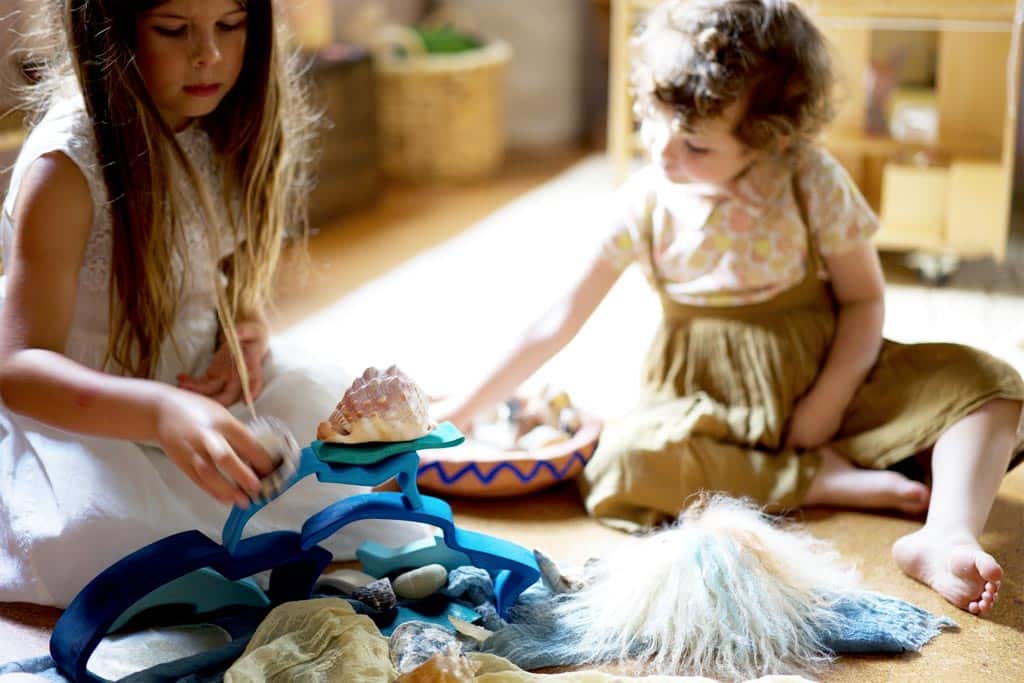Think of your child as a visitor from another planet—competent and curious, but witnessing everything for the first time. Their endless questions reflect their eagerness and natural desire to understand the mysterious world around them. They yearn to organize the observations, discoveries, and knowledge they gather to make sense of their surroundings. They use a powerful tool for this: imaginative play.
Children’s play is more than just fun. In the case of imaginative play, it’s an activity that promotes development in many areas. In this article, we’ll focus on how imaginative play fosters emotional intelligence, particularly empathy, and creativity in preschoolers. We’ll also suggest simple activities you can incorporate at home to support your child’s natural development.
- What Is Imaginative Play for Preschoolers?
- How Imaginative Play Fosters Creativity in Preschoolers
- Encouraging Empathy Through Imaginative Play
- Simple Imaginative Play Activities to Try at Home
- How to Create a Space That Encourages Imaginative Play
- The Role of Parents in Supporting Imaginative Play
- Importance of Imaginative Play
What Is Imaginative Play for Preschoolers?
Imaginative play (also called pretend play, role play, or “make-believe”) allows children to explore the world from different perspectives through imagination. It can mean acting out scenes with small animal figurines, playing “store” and pretending to be the cashier, playing with dolls, pretending to be a dragon, or even sitting quietly and imagining a story of their own.
In this safe environment, children practice social interactions, attempt to understand how the world works, hypothesize, solidify their discoveries, and test their ideas. As you can see, even the simplest play offers substantial developmental strides, and your preschooler has a natural desire to follow this path. It’s worth observing this with wonder.

How Imaginative Play Fosters Creativity in Preschoolers
One of the key benefits of imaginative play is that it stimulates creativity in preschoolers. When children engage in make-believe play, they’re not following a set script—they’re creating one. They use their imagination to think outside the box, test ideas, solve problems, and invent entirely new worlds.
A preschooler pretending to be a superhero on a mission to save the world, or a group of kids playing house or restaurant where each one has a role, are spending their time very fruitfully. Through creating fictional situations, imagining characters, and crafting scenarios, children lay the foundation for innovative thinking in the future.
Encouraging Empathy Through Imaginative Play
Understanding perspectives other than their own is a big achievement for young children. This skill is largely supported by imaginative play. Thinking in preschoolers (and sometimes in early school-age children), is associated with egocentrism, which means they have difficulty understanding emotions and perspectives different from their own.
Play, as a fundamental developmental tool, also plays a major role in emotional development and fostering empathy in children. When pretending to be different characters or role-playing others (like a simple game of doctor and patient or “good” and “bad” characters), children start to grasp the diversity of perspectives. They recognize differences in how people perceive situations, their unique emotions, and needs, and learn to respond to them. These are the basic components of emotional intelligence. Through imaginative play, children develop sensitivity to others’ feelings, which leads to kindness and a willingness to help others.
Simple Imaginative Play Activities to Try at Home
Imaginative play is all about the child’s ideas, not the adult’s. However, by providing an environment with inspiring objects, we can initiate this type of play that encourages exploration. Here are a few easy ways to introduce imaginative play into your child’s daily activities. Here are some preschool play ideas that children are sure to love:
- Dress-Up Games: Give your child old clothes, hats, colorful fabrics, or costumes, which will encourage them to create characters or scenarios. You could also offer face paints to help them become a superhero, an animal, or anything else they want to be.
- Puppet Shows: Use hand puppets, finger puppets, or make simple ones from items around the house (socks, wooden spoons, cardboard) to act out stories together. This is a great way for children to explore different roles and emotions.
- Storytime role-playing: After reading a book together, encourage your child to act out scenes from the story. This helps them internalize the narrative and explore different perspectives.
- Using Household Objects for Play: Allow your child to use kitchen utensils, safe garage tools, items from the medicine cabinet, or hair accessories. These objects can inspire hours of creative play.
These activities are low-cost, require minimal preparation, and can be tailored to your child’s interests.

How to Create a Space That Encourages Imaginative Play
The environment where a child spends time plays a significant role in stimulating imagination. Here are some tips for creating a space that fosters imaginative play:
- Use Open-Ended Toys: Toys like building blocks, figurines, and dolls allow children to create their own scenarios instead of following predefined rules. This freedom encourages more creative and varied play.
- Rotate Toys: Having too many toys can overwhelm children and stifle creativity. Rotating toys (e.g., weekly) keeps play fresh and encourages children to explore each item more deeply.
- Create Themed Play Areas: You don’t need a lot of space or resources—a small area dedicated to a specific theme can inspire imaginative play. Use furniture you already have in new arrangements or large cardboard boxes decorated to spark associations with a kitchen, car repair shop, doctor’s office, or store.

The Role of Parents in Supporting Imaginative Play
While imaginative play should be child-led, parents play an important role in supporting and encouraging it. Here’s how you can help:
- Provide Resources: Offer the toys, materials, and themed play zones mentioned above. But let your child decide how to use them.
- Encourage Free Exploration: Let your child lead the play. Instead of giving instructions, ask questions that spark curiosity, like “What do you think will happen next?”, “Can you tell me more about your character?”, “Hmm, what could we do in this tent?” or “How do you think we can use these face paints?”
- Join in Without Taking Over: Sometimes children want their parents to join their make-believe worlds. While we want to promote independent play, it’s okay to join in, but without taking over. Let your child guide the story and resist the urge to lead. This way, you’ll focus on their creativity while enjoying time together.
By being an active but non-directive participant, you can support your child’s imaginative play without interrupting their creative process.
Importance of Imaginative Play
Imaginative play is something children do instinctively. As a parent, however, it’s worth being aware of when it happens, what purpose it serves, and how to support it.
By offering the space and tools necessary for free imaginative play, you’re giving your child a wonderful foundation for emotional and intellectual development, which will benefit them throughout their life.




